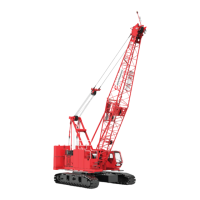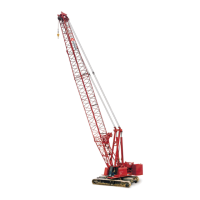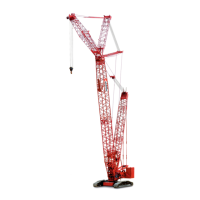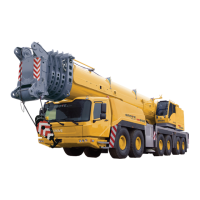Manitowoc Published 11-22-17, Control # 257-02 10-25
MLC300 SERVICE/MAINTENANCE MANUAL ACCESSORIES
10
SELF-ERECT CYLINDER
General
This part of Section 10 provides operational information and
electrical and hydraulic schematics for the self-erect cylinder
system.
Additional component information for this system can be
found in the following sections of the Service Manual:
• Section 2: Hydraulics
• Section 3: Electrical
The self-erect cylinder is controlled by the center control
handle on the right console (joystick J4).
See Figure 10-18
and Figure 10-19 for the following
descriptions.
Joystick J4 Control
Joystick J4 communicates with the CCM-10 control module
via the controller area network bus (CAN Bus). The crane
control modules use the CAN Bus to communicate with each
other.
To operate the self-erect cylinder, the setup mode must be
turned on as instructed in the MLC300 Operator Manual.
Also, on current production cranes (software version CCM-
10 0.022 and newer) the self-erect cylinder must be turned
on as instructed in the MLC300 Main Display Manual.
Neutral
When there is no command from joystick J4:
• Pump 3 hydraulic flow through system B (right valve
assembly) decreases.
• The isolation valve B shifts to neutral to block pump flow
to the self-erect cylinder valve.
• The self-erect valve shifts to neutral to block pump flow
to the self-erect cylinder.
• The load holding valve closes to lock the self-erect
cylinder in position.
Hoist (retract)
When a hoist command is sent by joystick J4 to CCM-10
control module, the CCM-10 control module communicates
the hoist command to the IOLC30 control module via CAN
Bus C.
The following then occurs:
• The CCM-10 control module increases the PWM current
to pump 3 to increase system B (right valve assembly)
hydraulic flow.
• The IOLC30 control module sends 24 V
DC
to the side B
solenoid on isolation valve B. The solenoid energizes
because the CCMC11 control module provides a ground
for the solenoid. The energized solenoid shifts the valve
spool to a position that routes hydraulic fluid to the self-
erect cylinder valve.
• The IOLC30 control module then sends 24 V
DC
to the
corresponding solenoid on the self-erect cylinder valve,
energizing the solenoid. The valve shifts to a position
that routes hydraulic fluid to the load holding valve at the
rod end of the self-erect cylinder.
• The hydraulic fluid bypasses the load holding valve by
flowing through a check valve, then to the rod end of the
self-erect cylinder. The rod retracts to hoist the load.
This action forces hydraulic fluid out the barrel end of the
self-erect cylinder and back to the tank via the self-erect
cylinder valve.
Load Holding
If system pressure is lost, the check valve closes and the
load holding valve locks the self-erect cylinder in position.
Lower (extend)
When a lower command is sent by joystick J4 to CCM-10
control module, the CCM-10 control module communicates
the lower command to the IOLC30 control module via CAN
Bus C.
The following then occurs:
• The CCM-10 control module increases the PWM current
to pump 3 to increase system B (right valve assembly)
hydraulic flow.
• The IOLC30 control module sends 24 V
DC
to the side B
solenoid on isolation valve B. The solenoid energizes
because the CCMC11 control module provides a ground
for the solenoid. The energized solenoid shifts the valve
spool to a position that routes hydraulic fluid to the self-
erect cylinder valve.
• The IOLC30 control module then sends 24 V
DC
to the
corresponding solenoid on the self-erect cylinder valve,
energizing the solenoid. The valve shifts to a position
that routes hydraulic fluid to the barrel end of the self-
erect cylinder.
• Barrel end pilot pressure opens the load holding valve.
As hydraulic fluid fills the barrel end of the self-erect
cylinder, the rod extends to lower the load. This action
forces hydraulic fluid out the rod end of the cylinder,
through the open holding valve, and back to the tank via
the self-erect cylinder valve.

